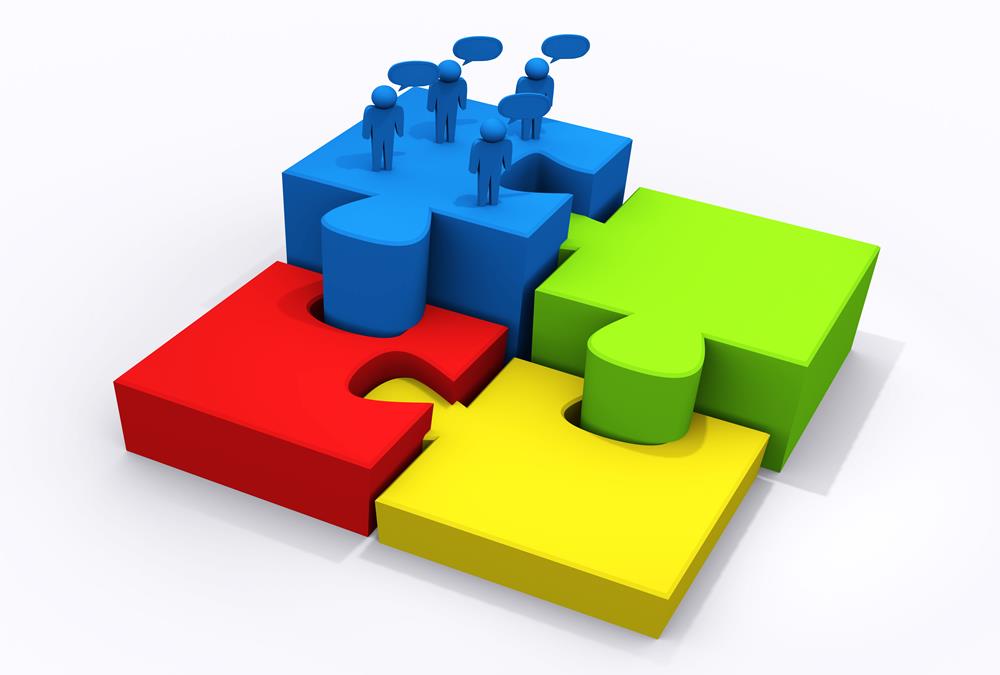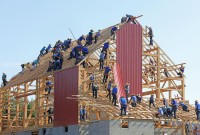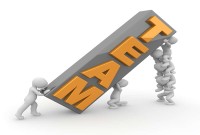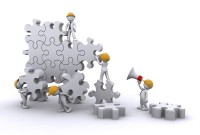- Home
- Business Processes
- Industry Knowledge
- Aerospace Industry
- Automotive Industry
- Banking Domain
- BFSI Industry
- Consumer/ FMCG Industry
- Chemicals Industry
- Engineering & Construction
- Energy Industry
- Education Domain
- Finance Domain
- Hospitality Domain
- Healthcare Industry
- Insurance Domain
- Retail Industry
- Travel and Tourism Domain
- Telecom Industry
- Leadership Skills
- eLearning
- Home
- Leadership
- Leadership Theories
- Qualities of Leadership
Qualities of Leadership
The ten most important qualities that define a good leader are self-awareness, interpersonal and communication skills, ethical values, organizational consciousness, self-confidence, adaptability and flexibility, imagination and creativity, focus & result-orientation, continuous self-development and accountability and ownership for his actions. These ten qualities of leadership every good leader should possess to a certain extent and must continually strive to develop them.
Leadership is much more complex than merely earning a high-status position in a company, and the ability to order people to do things. It is a participative journey that the leader must be willing to walk with others. It is a skill that’s acquired over a lifetime, and these characteristics are something we can practice about every day of our life. A great leader is one who learns from his mistakes and believes in continuous self-improvement.
Leadership qualities are an interesting topic because some people wonder if they possess these characteristics without completely understanding what they might be. In other words, we have people trying to figure out if they are leaders, but they do not really understand what defines a leader. Let us take a close look at some of the qualities and characteristics of a leader.
Listed below are the ten most important leadership qualities and characteristics
1. Interpersonal Skills
The first leadership characteristic is interpersonal skills. Leaders that have earned the trust and respect of their followers can use this trust to move the organization towards the achievements of its goal. These leaders are able to use their interpersonal skills to work through difficult relationships and keep peace in their departments.
These individuals are good at listening as well as providing constructive feedback. The leader develops co-operative relations among individuals within and outside the organization
Read more on how to Develop Interpersonal Skills
2. Communication Skills
Leaders demonstrating communication skills are both good speakers and listeners. Through their words, they can help keep the workforce motivated and committed. They also listen to their followers and ask questions when they want to make sure they have a good understanding of what is being expressed.
The leader listens closely to people at work and organizes and clearly presents information both orally and in writing. Communicate with all personnel with a sense of mutual understanding and mutual loyalty to generate enthusiasm for projects and inspire working towards the completion of organizational objectives.
Develop your communication Skills
3. Ethics and Values
Leadership is not by itself good or desirable. Leadership is a means for achieving end results. Ethics and values decide what type of results is achieved through leadership.
From history, we know that there are many charismatic leaders like Hitler, Stalin, and Mao who have been successful in their missions but inflicted quite a lot of evil, misery, and suffering on humanity. The subtle difference between a successful leader and an effective leader lies in the "fact that a successful leader merely changes the behavior of followers whereas effective leader brings about an enduring change in the attitudes of followers. Attitude is the way one looks at things mentally; Such Leaders operate with a high level of ethics, which becomes an example for others to follow.
The leader acts consistently with the principles of fairness and right or good conduct that can stand the test of close public scrutiny. The leader comfortably handles vague and difficult situations where there is no simple answer or no prescribed method of proceeding.
For example, ethical leaders must value the diversity of a workforce, and understand that a diverse group of employees will bring a broader perspective to the organization. They must treat followers with the respect they deserve and do not display favoritism.
4. Organizational Consciousness
Leadership characteristics sometimes go beyond personal traits and touch on areas such as organizational consciousness or knowledge. These are leaders that understand what the organization wants to achieve, and know how it can be accomplished. They create networks within the organization to help their groups get work done, and are just as adept at breaking down organizational barriers to progress.
Leaders are visionary and look into the future and create new ways in which the organization can prosper. The leader in collaboration with others develops strategies for achieving organizational objectives. The leader makes timely decisions that are in the best interest of the organization by analyzing all available information, distilling key points, and drawing relevant conclusions. The leader appropriately and effectively assigns responsibility and authority.
The leader shows commitment to achieve goals and strives to keep improving performance
5. Self-Confidence
Leaders need to carry themselves with confidence, and should not be afraid to take ownership of both popular and unpopular decisions. They must be able to learn from criticisms, and be often acutely aware of their own shortcomings. Confident leaders are able to maintain a calm demeanor even during emergencies, and this can be contagious when it needs to be.
The leader appears secure about abilities and recognizes personal shortcomings. The leader uses appropriate and variety of leadership styles to motivate and guide others towards attaining the common goals. The leader shows genuine concern for the feeling of others and respects individuals as individuals. The leader willingly tries out new ideas in spite of possible loss or failure. The leader frequently introduces new ideas.
6. Flexibility & Adaptability
Leaders have a deep understanding of what an organization needs to accomplish, they are able to quickly identify and solve the important objectives of an organization. The leader identifies, collects, organizes, and analyses the essential information needed by the organization.
Another important characteristic of leaders is their ability to remain flexible and adapt their leadership style to meet the demands of the current work environment. They must be able to work with others to meet organizational goals and shift focus as necessary.
The leader encourages and accepts suggestions and constructive criticism from coworkers, and is willing to consider modifying the plans. The leader continues to act on his beliefs despite the unexpected difficulty. The leader brings conflict into the open and uses it to arrive at constructive solutions. The leader acts tolerant even when things don't go as planned. The leader effectively deals with the demands of high-pressure work situations.
7. Imagination & Creativity Skills
Leadership requires vision, courage, understanding, determination, decisiveness, sense of timing, capacity to act, ability to inspire, etc.
Leaders demonstrating creativity skills are able to develop innovative solutions to old problems. The diversity they build in their organizations helps them to develop more comprehensive answers to routine questions. Creative leaders are able to translate technical information into solutions that are understood by everyone.
Creative leaders go beyond normal expectations by inspiring new ways of thinking, stimulating learning experiences, and transmitting a sense of mission. These leaders are sometimes called super leaders. They act in such a way that it is possible to transform the average organization into an exceptional organization.
8 Achieving Results
Leaders establish vision and mission and set the direction for the organization, communicate the vision to the people in the organization and synchronize them with the organizational vision and mission, thereby inspire the people to translate the goals, vision, and mission into reality.
Leaders just do not set an example for others to follow. They also play a big role in achieving the goals of the organization. Through their leadership skills, they maintain a high level of performance in their organizations, and they are able to help keep their workforce motivated even when faced with a seemingly impossible situation.
The leader works for the benefit of the entire organization and not just for self.
9 Seeks Self-improvement
As an effective human being, a leader should have identity, authenticity, open-mindedness, independence, responsibility, communicating, reasoning and problem-solving abilities, concern for others, rest for life energy, maturity, courage (guts), a strong sense of obligation, clarity of mind and expression, integrity, etc.
Any leader needs to know in terms of what he has done, can do, and is willing to do. Once these are identified, then the leader can constantly build on improving his skill sets. A good leader is someone who is always evolving in one form or the other. A leader is technically proficient, works to understand the job, and have a solid familiarity with the tasks that one wishes others to accomplish. Technically proficient also translates into possessing the ability to delegate the responsibility to various members of the group and be able to guide them in achieving common goals.
10 Takes Ownership & Accountability
A leader always seeks responsibility and takes responsibility for his actions. As a leader one needs to search for ways to take the organization to new heights. When things go wrong, a true leader always accepts the responsibility for failure and takes the blame on to him and does not search for scapegoats. This is one characteristic that always defines true leaders. Taking responsibility means that the leader had a plan and he tried his best to meet the goals but might be due to unanticipated events some eventuality has occurred, for which he willingly takes responsibility for the actions.
What are the 5 qualities of a good leader?
Considering the above, we can further say that the top five characteristics of leadership are as follows:
- The leader acts as an ideal for his followers and gains trust and respect
- Leader and the followers influence each other
- The leader controls the other member of the group.
- The leader determines the group’s conduct.
- The leader is a respected and revered person
Related Links
You May Also Like
-
Principles of management are fundamental concepts and advisory guidelines for managerial decision making. By using management principles, managers can more easily achieve the objectives and avoid making mistakes in their activities. Management principles can be applied to any kind of organization and to managers at all organizational levels.
-
Leadership has been defined in different ways by different sets of scholars. In very simple terms leadership can be defined as the skill of a person to influence an individual or a group for achievement of a goal in a given situation. One can use different dimensions and perspectives to define leadership. Through the evolution of leadership thought, leadership has been defined in various ways discussed here.
-
Theory Z also called the "Japanese Management" style is a leadership theory of human motivation focused on organizational behavior, communication, and development. It assumes that employees want to enter into long term partnerships with their employers and peers. Offering stable jobs with an associated focus on the well-being of employees results in increased employee loyalty to the company.
-
There are four characteristics of leadership that help us to understand the character of leadership as a concept. 1. Leadership is a process, 2. Leadership involves influence, 3. Leadership always occurs in a group context and 4. Leadership involves goal attainment. These are the four components that make up the character of the 'leadership' term and help us to define the leadership concept. All of these components of leadership have common characteristics.
-
Team Foundation in Forming Stage
This is the first stage of team development. This is the stage when the foundation of the team is laid. During the Forming stage, team members have a high dependence on their leader for guidance. Learn the practical strategies you can use during this stage to help your team develop into a highly effective performing team.
-
Managers have to perform many roles in an organization, and how they handle various situations will depend on their style of management. Management styles are the characteristic ways, of making decisions relating to subordinates. These are the strategies, efforts, or direction used by the manager, to create an efficient workplace, to achieve organizational goals. A management style is the method of leadership used by a manager.
-
The development of teams is an ongoing process because the composition of the team may keep on changing. The new members may join and the old members may leave the team. The team members pass through several stages for the development of the team and there has been a lot of research to identify these stages. In this article, we discuss the common theories of team development.
-
In this study of power, Raven identified five bases of power as coercive, reward, legitimate, referent, and expert. The 5 Types of Power can help you decide when it is appropriate to use a particular type of power in important situations. Leadership involves authority and it is very important for leaders to understand what type of power they're using.
-
Management theories are the recommended management strategies that enable us to better understand and approach management. Many management frameworks and guidelines were developed during the last four decades.
-
Power is the ability to exercise influence or control over others. Leadership involves authority and it is very important for leaders to understand what type of power they're using. The 5 Types of Power in Leadership are Coercive power, expert power, legitimate power, referent power, and reward power. Authority is the right to command and extract obedience from others. It comes from the organization and it allows the leader to use power.
Explore Our Free Training Articles or
Sign Up to Start With Our eLearning Courses

About Us
Learning
© 2023 TechnoFunc, All Rights Reserved










